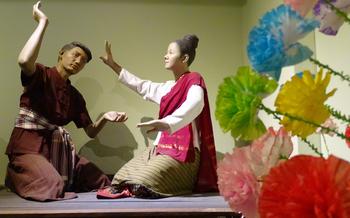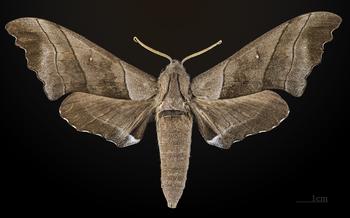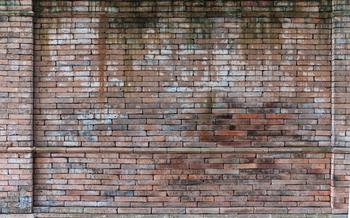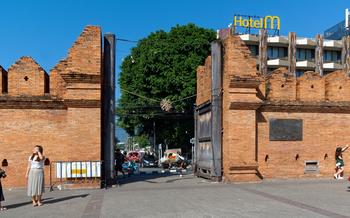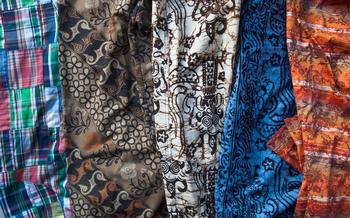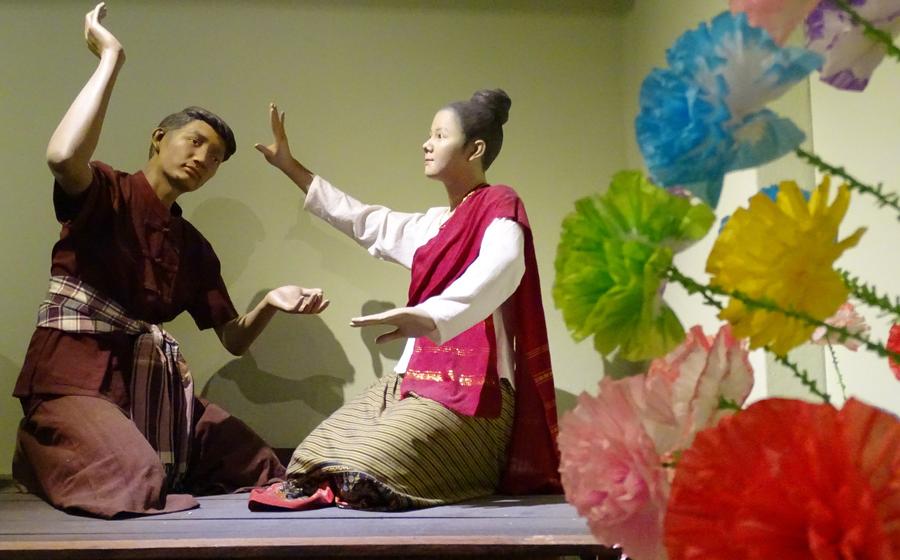
Lanna Folklife Museum
- Historical Background
- Location
- Architecture and Design
- Exhibits and Collections
- Lanna Culture and Lifestyle
- Traditional Lanna Crafts
- Interactive Activities
- Lanna Cuisine
- Educational Programs
- Community Involvement
- Sustainable Tourism
- Accessibility
- Hours of Operation and Admission Fees
- Photography and Videography
- Insider Tip
Historical Background
The Lanna Kingdom, a significant realm in the history of northern Thailand, existed from the 13th to the 16th century. It was renowned for its unique culture, art, and architecture and played a pivotal role in shaping the region's identity. The Lanna Folklife Museum, established in 1975, serves as a testament to the kingdom's rich legacy and the enduring traditions of the Lanna people. It was founded by a group of local scholars and enthusiasts who recognized the importance of preserving and showcasing the region's cultural heritage. They aimed to create a space where visitors could learn about the Lanna way of life, appreciate its intricate crafts, and gain insights into the historical significance of the kingdom.
Location
The Lanna Folklife Museum is conveniently located in the heart of Chiang Mai, on Rajdamnoen Road, near the famous Tha Pae Gate. It is easily accessible by foot, bicycle, or public transportation. Visitors can also opt for a tuk-tuk or songthaew ride to reach the museum from other parts of the city.
The museum's proximity to several other historical and cultural attractions makes it an ideal starting point for a day of exploration in Chiang Mai. Within walking distance, visitors can find the Chiang Mai City Arts & Cultural Centre, the Three Kings Monument, and the Wat Phra Singh temple. The bustling Chiang Mai Night Bazaar and the Sunday Walking Street Market are also just a short walk away.
Architecture and Design
The Lanna Folklife Museum is housed in a collection of beautiful teakwood buildings, which were constructed using traditional Lanna techniques and architecture. These buildings are adorned with intricate carvings and colorful murals that depict scenes from Lanna history and mythology. The museum grounds are also landscaped with lush gardens and ponds, which create a serene and picturesque atmosphere.
One of the most striking architectural features of the museum is its main building, known as the "Ho Kham". This two-story building is constructed entirely of teakwood and features a steep, tiered roof that is reminiscent of traditional Lanna temples. The Ho Kham also boasts a wide veranda with carved wooden pillars and a large, open courtyard that is used for cultural performances and demonstrations.
Inside the museum, visitors can admire the intricate carvings and murals that adorn the walls and ceilings of the buildings. These artworks depict scenes from Lanna history, mythology, and everyday life, and provide a fascinating glimpse into the culture and traditions of the Lanna people. The museum also features a number of traditional Lanna-style furniture and artifacts, which help to create a truly immersive experience for visitors.
Exhibits and Collections
The Lanna Folklife Museum houses a diverse collection of artifacts and exhibits that showcase the rich cultural heritage of the Lanna Kingdom. Visitors can explore various galleries dedicated to different aspects of Lanna life, including traditional costumes, textiles, pottery, musical instruments, and agricultural tools.
One of the highlights of the museum is the collection of Lanna textiles, which are renowned for their intricate designs and vibrant colors. Visitors can admire the intricate embroidery, weaving, and dyeing techniques that have been passed down through generations of Lanna artisans.
The museum also features a replica of a traditional Lanna house, providing visitors with a glimpse into the domestic life of the Lanna people. The house is furnished with authentic furniture, utensils, and decorations, offering a tangible connection to the region's past.
Other notable exhibits include a collection of ancient Lanna manuscripts, which provide valuable insights into the kingdom's history, literature, and religious beliefs. There is also a display of traditional Lanna musical instruments, such as the khene, a bamboo mouth organ, and the saw sam sai, a three-stringed fiddle.
Lanna Culture and Lifestyle
The Lanna Folklife Museum offers a fascinating glimpse into the rich and diverse culture and lifestyle of the Lanna people. This museum houses a vast collection of artifacts, displays, and interactive exhibits that showcase Lanna traditions, beliefs, and rituals. Visitors can learn about the unique customs and traditions that have shaped the Lanna identity, from their vibrant festivals and ceremonies to their intricate system of beliefs and practices. The museum's exhibits also shed light on the Lanna people's relationship with the natural world, their agricultural practices, and their intricate system of traditional medicine. By exploring the Lanna Folklife Museum, visitors gain a deeper understanding and appreciation for this unique and captivating culture.
Traditional Lanna Crafts
The Lanna Folklife Museum offers visitors a unique opportunity to witness and learn about traditional Lanna crafts. These crafts, passed down from generation to generation, showcase the creativity and skills of the Lanna people.
In the museum's workshops, skilled artisans demonstrate their mastery of various crafts, including weaving, pottery, and lacquerware. Visitors can observe the intricate processes involved in creating these beautiful and functional objects.
Weaving is a particularly important craft in Lanna culture, and the museum showcases a wide variety of woven textiles, including intricate silk and cotton fabrics. Visitors can admire the vibrant colors and patterns of these textiles, which often incorporate traditional Lanna motifs.
Pottery is another important craft in the region, and the museum exhibits a collection of beautifully crafted ceramic pieces. Visitors can learn about the techniques used to create these pieces, from the selection of clay to the firing process.
Lacquerware, a technique that involves applying multiple layers of lacquer to create a smooth, durable finish, is another highlight of the museum's collection. Visitors can admire the intricate designs and delicate details of these lacquerware pieces, which range from bowls and plates to furniture and decorative objects.
The museum also provides opportunities for visitors to purchase handmade souvenirs, allowing them to take home a piece of Lanna culture to cherish. These souvenirs range from woven textiles and pottery to lacquerware and other handcrafted items.
By showcasing traditional Lanna crafts, the museum plays a vital role in preserving and promoting the cultural heritage of the region. Visitors to the museum can gain a deep appreciation for the skills and creativity of the Lanna people, while also supporting the local economy.
Interactive Activities
Beyond its captivating displays, the Lanna Folklife Museum offers an array of interactive activities that bring Lanna culture to life. Visitors can immerse themselves in the traditional arts and crafts of the region through hands-on workshops. Learn the intricate art of weaving from skilled artisans, try your hand at pottery using ancient techniques, or discover the secrets of creating exquisite lacquerware. These workshops provide a unique opportunity to connect with the local community and gain firsthand experience in these cherished traditions.
Cooking enthusiasts can participate in culinary classes that delve into the flavors and aromas of Lanna cuisine. Expert chefs guide participants through the preparation of classic dishes, sharing insights into the unique ingredients and cooking methods that define this regional gastronomy. As you create your own culinary masterpieces, you'll not only learn about Lanna cuisine but also gain a deeper appreciation for the region's rich culinary heritage.
Cultural performances are another highlight of the museum's interactive offerings. Throughout the day, visitors can witness captivating shows that showcase traditional Lanna dance, music, and storytelling. These performances provide a glimpse into the vibrant artistic expressions of the Lanna people and offer a unique opportunity to experience the region's cultural heritage in its most dynamic form.
Lanna Cuisine
Lanna cuisine, with its vibrant flavors and unique ingredients, is a testament to the region's rich cultural heritage. At the Lanna Folklife Museum, visitors have the opportunity to savor the delights of this culinary tradition at the on-site restaurant. The menu features a variety of traditional dishes, each prepared with fresh, local ingredients and cooked to perfection.
From the fiery khao soi, a coconut-based curry noodle soup, to the aromatic sai ua, a grilled pork sausage infused with lemongrass and kaffir lime leaves, the flavors of Lanna cuisine are sure to tantalize taste buds. Vegetarian options are also available, such as the refreshing khao chae, a cold rice dish served with a variety of toppings and condiments.
To complete the dining experience, visitors can indulge in a selection of sweet treats, including the famous khanom jeen, a sticky rice dessert topped with sweet coconut cream, or the delicate foi thong, golden egg yolk threads served in a sweet syrup.
Whether you're a foodie looking to explore new culinary horizons or simply someone who appreciates a delicious meal, the Lanna Folklife Museum's restaurant is a must-visit for anyone interested in experiencing the true essence of Lanna culture.
Educational Programs
The Lanna Folklife Museum offers a range of educational programs to enhance visitors' understanding and appreciation of Lanna culture. School groups can arrange guided tours that introduce students to the history, traditions, and craftsmanship of the Lanna people. These tours are tailored to different grade levels, ensuring that students grasp the information in a fun and engaging manner.
The museum also hosts workshops and seminars for researchers and scholars interested in delving deeper into Lanna studies. These programs provide a platform for experts to share their knowledge, conduct research, and collaborate on projects related to Lanna culture. The museum's extensive collection of artifacts and resources serves as a valuable foundation for academic research and exploration.
Additionally, the museum offers hands-on activities and classes for visitors of all ages to experience Lanna culture firsthand. Cooking classes introduce participants to the unique flavors and techniques of Lanna cuisine. Weaving workshops allow visitors to try their hand at creating traditional Lanna textiles using looms and natural dyes. Through these interactive programs, the museum fosters a deeper understanding and appreciation for the rich cultural heritage of the Lanna people.
Community Involvement
The Lanna Folklife Museum is deeply committed to preserving and promoting Lanna culture and traditions. It plays an integral role in the local community by organizing and participating in various outreach programs and initiatives. These efforts aim to raise awareness about Lanna heritage and foster cultural pride among the younger generation.
The museum collaborates with local schools and universities to offer educational workshops, lectures, and field trips. Students are given hands-on experiences with traditional crafts, such as weaving, pottery, and lacquerware. These programs help to instill an appreciation for Lanna's rich cultural legacy and encourage students to preserve and protect it for future generations.
The museum also hosts community events, festivals, and performances throughout the year. These events provide a platform for local artists, musicians, and performers to showcase their talents and share the vibrant spirit of Lanna culture with visitors. The museum's restaurant serves as a hub for culinary enthusiasts to savor authentic Lanna cuisine and learn about the unique flavors and ingredients that define this regional gastronomy.
By engaging the local community in its activities and programs, the Lanna Folklife Museum fosters a sense of ownership and shared responsibility for the preservation of Lanna heritage. This collaborative approach ensures that the museum remains a vital and dynamic institution, deeply rooted in the community it serves.
Sustainable Tourism
The Lanna Folklife Museum is committed to promoting sustainable tourism practices that minimize environmental impact and support local communities. The museum uses energy-saving lighting and appliances, recycles waste, and promotes the use of eco-friendly materials. It also works with local artisans and craftspeople to create and sell handmade souvenirs, ensuring that visitors can support the local economy while taking home unique mementos of their visit.
By adopting these practices, the museum sets an example for other tourist attractions in Chiang Mai and beyond. It demonstrates that it is possible to provide a rich and rewarding cultural experience while also protecting the environment and supporting the local community. Visitors to the Lanna Folklife Museum can feel good knowing that they are contributing to a sustainable tourism model that benefits everyone involved.
Accessibility
The Lanna Folklife Museum is committed to providing a welcoming and accessible environment for all visitors, regardless of their abilities. The museum has a number of features to make it accessible to visitors with disabilities, including:
-
Wheelchair ramps and elevators: The museum is fully wheelchair accessible, with ramps and elevators connecting all floors.
-
Accessible restrooms: There are accessible restrooms located on every floor of the museum.
-
Assistive listening devices: Assistive listening devices are available for visitors who are deaf or hard of hearing.
-
Large print and Braille signage: The museum has large print and Braille signage throughout the building, making it easier for visitors with visual impairments to navigate the space.
-
Staff training: The museum staff is trained to be welcoming and helpful to visitors with disabilities.
With these features in place, the Lanna Folklife Museum is a welcoming and accessible place for all visitors to learn about and experience Lanna culture.
Hours of Operation and Admission Fees
The Lanna Folklife Museum is open to visitors from Tuesday to Sunday, from 8:30 AM to 4:30 PM. It remains closed on Mondays and national holidays. The museum offers a range of ticket options to suit different preferences and budgets:
- Standard Admission: This ticket grants access to all the museum's exhibits and galleries.
- Student Admission: Students with valid ID can avail discounted tickets.
- Family Pass: Families with children can purchase a family pass for a discounted rate.
- Group Discounts: Groups of 10 or more visitors can enjoy discounted group rates.
Photography and videography are allowed inside the museum for personal use. However, commercial photography or filming requires prior permission from the museum's management.
Plan your visit during the museum's regular hours and take advantage of the ticket options available to make your visit more affordable. Remember to bring your student ID or relevant documentation if you're eligible for discounted rates.
Photography and Videography
Photography and videography are allowed inside the Lanna Folklife Museum, but with certain restrictions. Flash photography is not permitted, as it can damage the delicate artifacts and exhibits. Tripods are also not allowed, as they can obstruct the flow of visitors. For those who wish to capture their memories, it's best to use a handheld camera or smartphone.
To capture the best shots, try to visit the museum during off-peak hours when there are fewer crowds. This will give you more space to move around and take your time photographing the exhibits. Be sure to pay attention to the lighting, as the natural light coming through the windows can create beautiful effects.
If you're interested in capturing the vibrant colors and intricate details of the Lanna textiles, be sure to visit the weaving workshop, where you can see the artisans at work. You can also take photos of the finished products, which are displayed in the museum shop.
After your visit, you can share your photos and videos with friends and family, or post them on social media to inspire others to explore the rich cultural heritage of the Lanna people.
Insider Tip
One insider tip for visitors to the Lanna Folklife Museum is to explore the back garden, where you'll find a tranquil pond with blooming lotuses and a charming wooden gazebo. Take a moment to sit here and soak in the serene atmosphere. This hidden gem is a perfect spot to escape the crowds and enjoy a quiet moment of reflection.
